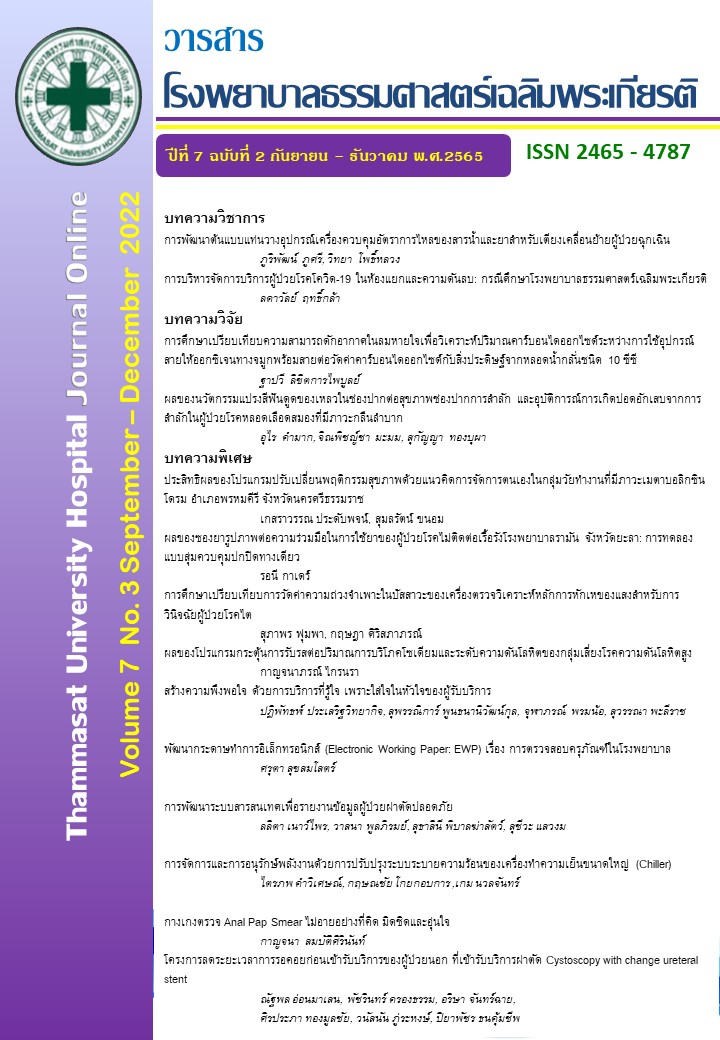Improve Condenser Efficiency for Water Cool Chiller
Keywords:
Electricity saving, Energy saving, Chiller, Cooling Tower, Approach TemperatureAbstract
Introduction: The refrigeration system is a very important system in a hospital, because it is a system that supports the service of patients and those who come to use the service. In addition, in terms of services and support such as temperature and humidity control, it is related to the refrigeration system.
Objectives: 1. To improve the cooling system of the chiller to have better performance, be stable, not to cause the shutdown itself from the cooling machine that is not being able to catch up. 2. In order to be able to provide continuous service to customers and ensure safety for patients, including effective control of electrical energy consumption, energy costs and emissions reduction of greenhouse gas.
Research Methodology: The project was conducted according to the Plan do check Act framework and proceeded from designing and installing to make pipe and valve sizes suitable according to engineering principles, modifying the motor that drives the condenser pump to meet the specifications. Additionally, install a pump speed control device (VSD) to be able to adjust the operation to save energy and install a scale reduction system to contribute to long-term energy conservation, which has advantages in terms of efficiency and low operating cost.
Discussion and Results: It was found that the temperature difference of the water entering and leaving the chiller on the condenser side was controlled in the range of 6-10 degrees Fahrenheit, meaning that the water flow was sufficient for cooling, and it can control the Approach Temperature at no more than 3 degrees Fahrenheit. Although the manufacturer's standards set that it can be as high as 10 degrees Fahrenheit, but it is not a cost-effective value to save energy. This is because when the temperature rises by 1degree Fahrenheit, the efficiency will be reduced by 1-1.5%. The savings from the calculation are 3.52 million baht (investment 2.8 million), which comes from 2 parts: savings when switching from an ozone system to a pulse-powered scale reduction system (Vulcan WE) which accumulated the operating cost savings over 6 years in total amount of 466,206 baht. Savings arising from pipe system improvements including results from scaling reduction system improvements accumulated over 6 years equal to 3,056,628.36 baht. Cumulative greenhouse gas emissions for 6 years in total of 317,112.35 kg.
Conclusion: Applying engineering knowledge to improve the large cooling system of the hospital resulted in stability for the operation of the machine itself with improved efficiency, saved energy, reduced costs and reduced greenhouse gas emissions. Also, it can make a system that promotes to maintain long-term efficiency.
References
กระทรวงพลังงาน. กรมพัฒนาพลังงานทดแทน และอนุรักษณ์พลังงาน. คู่มือหลักสูตร “การพัฒนาบุคลากรภาคปฏิบัติเพื่อการปรับปรุงประสิทธิภาพการใช้พลังงานของเครื่องจักรและอุปกรณ์ตามเกณฑ์มาตรฐานการใช้พลังงานในระบบปรับอากาศ [Internet]. 2555 [เข้าถึงเมื่อ 2 มกราคม 2565]. เข้าถึงได้จาก: http://lib.Med. psu.ac.th/pdf/van01.pdf.
สาธิต เนียมสุวรรณ. วิธีการคำนวณการลดก๊าซเรือนกระจก ภายใต้โครงการ LESS [Internet]. กรุงเพทพมหานคร: องค์การบริหารจัดการก๊าซเรือนกระจก (องค์การมหาชน). [เข้าถึงเมื่อ 4 มกราคม 2565]. เข้าถึงได้จาก: https://ghgreduction. tgo.or.th /th/download-less/download/374/496/32.html.
Refrigerating. ASHRAE greenguide: the design, construction and operation of sustainable buildings [Internet]. 2006 [cited 2022 Jan 5]. Available from: https://www.academia.edu/38149795/ASHRAE_Green_Guide_pd.
Downloads
Published
How to Cite
Issue
Section
License
Copyright (c) 2022 Thammasat University Hospital Journal Online

This work is licensed under a Creative Commons Attribution-NonCommercial-NoDerivatives 4.0 International License.



